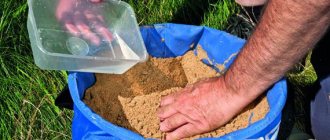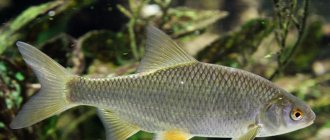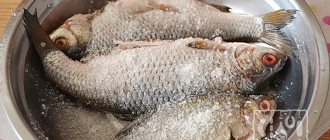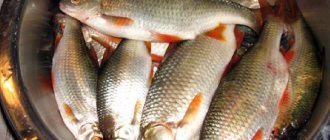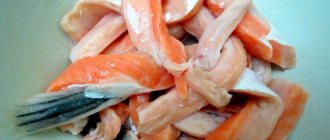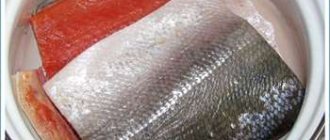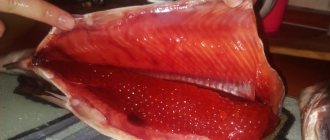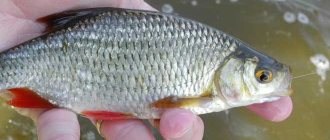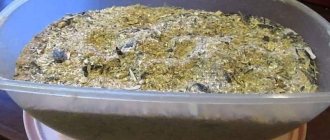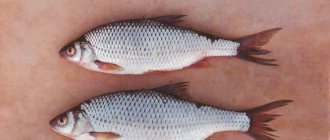Technology for preparing taranka for beer
Taranka for beer is loved not only by avid fishermen, but also by many lovers of a foamy drink who have never held a fishing rod in their hands.
We present to your attention a step-by-step method on how to make taranka at home, ideally combined with beer: it has an excellent taste and aroma, contains the right amount of fat (not too dry), is moderately salted, and can be stored well without losing its properties. Theory. Any freshwater fish is suitable for preparing ram: crucian carp, roach, bream, roach, pike, sabrefish, ram, rudd, ruff, perch, gudgeon and other species. Crucian carp, bream, perch and roach are often used for beer. It is better to take small and medium fish (250-900 grams), as it is well salted and does not spoil for a long time. Bream is considered the fattest, and ruff has few bones and very tender flesh that literally melts in your mouth. Taranka from perch is sweetish, from pike - slightly tart and piquant. Crucian carp is the golden mean in all respects. It is preferable to make ram from fresh, still living fish. To do this, it is advisable to transport the catch in wicker baskets, and arrange the fish with nettle leaves.
There are two ways to salt the ram: dry and wet. The wet method is simpler, but is only suitable for small fish weighing up to 400-500 grams and often worsens the aroma. Therefore, experienced fishermen salt taranka using a dry method.
Coarse rock salt without impurities or additives is required, as it draws out moisture well and does not saturate the meat with foreign odors. Iodized is not suitable!
You can salt fish for ramming in enamel dishes, as well as in glass or food-grade stainless steel containers, since these materials are not corroded by salt and do not affect the taste of homemade ramming.
Ingredients:
- fish – 1 kg;
- kitchen rock salt – 250-300 grams.
Taranka recipe
How to pickle a ram
1. Clean the fish from the entrails. Leave the scales.
It is not necessary to clean carcasses weighing up to 1 kg, since the husks will dry out, but it is still better to gut even small fish, since in the summer they feed on greens and microorganisms, which give off an unpleasant odor, and the finished ram has a bitter taste.
If you still decide to leave the insides, then 10-30 ml of a saturated salt solution (1 part water to 2-3 parts salt) should be poured into the throat of each still living fish; when the fish swallows the brine, the internal organs are well salted.
2. Rinse each fish thoroughly in running water to remove any remaining entrails. Pay special attention to the areas near the head and tail.
3. Cover the bottom of the pickling container with an even 1 cm layer of salt.
4. Salt the gills of each fish, rub the inside with salt, then make one puncture on each side with a fork and rub the top of the carcass well. The gills must be literally compacted with salt or removed altogether so that the ram is guaranteed not to deteriorate.
5. Place the salted fish in layers, one piece at a time. Place the carcasses side by side with the back to the belly and the head to the tail. Cover each layer with a layer of salt approximately 1 cm thick.
For better salting, it is better to place large fish on the bottom and small fish on top. One layer should contain fish of approximately the same size.
6. Place a cardboard or wooden board with holes on top of the fish. To cover round containers, you can use old lids of a smaller diameter. Holes are necessary for air access. Place a weight weighing 10-20 kg on top of the lid. For uniform salting, it is advisable to first add a weight of 5-10 kg, and after 6-8 hours add another 5-10 kg.
7. Transfer the container with the salted batter to a cool, dark place: refrigerator, cellar or basement. It is important that the fish are not exposed to direct sunlight. You can cover it with gauze to protect against insects.
The duration of salting the ram depends on the weight of the fish:
- up to 100 grams – 1-2 days;
- 600-800 grams – 3-4 days;
- from 800 grams – 5-14 days.
During the aging process, juice will be released, which must be drained every 8-12 hours. The ram is considered ready for drying when the juice is no longer released or its minimum amount is released.
8. Rinse each carcass in running water (especially the gills and middle), soak for 2 hours in cold water, removing excess salt. Then soak the ram for another 60 minutes in a vinegar solution (50 ml of 9% vinegar per 10 liters of water) to kill pathogenic microorganisms and repel flies and other insects when drying.
There is a rule among experienced fishermen: no matter how many days the fish is salted, the soaking in water should last for so many hours. This recommendation can be followed, but it is better not to skip the stage with the vinegar solution.
Drying homemade ram
9. Drain the water. Prepare 10-15 cm of rope for each carcass. Make a through puncture in the tails with an awl or needle. Push the rope into the hole, take it out from the other side and tie a knot to make a loop. In the bellies of large gutted fish, you can make 1-2 “spacers” from toothpicks to better dry the inside.
Drying upside down removes bitterness
It is correct to dry the ram upside down so that the bitterness from the gills does not transfer into the meat.
10. Hang each fish by its loops to hooks (made from wire) on a rope. For the first 2-3 hours, the knitting can be kept in one bunch, placing a container under it to drain the remaining brine.
11. When the liquid stops dripping, move the ram to dry on a balcony or other well-ventilated place with a high temperature, where there are no flies. Place the carcasses at a distance of at least 5-7 cm from each other.
The more heat and sun, the faster the carcasses dry out. In 2-4 days you will get dried fish, and the ram will become completely dry in 10-14 days.
How to store a battering ram
12. Ready, well-dried taranka is stored for up to 4 months in tin jars with a tight-fitting lid or wrapped in parchment. The shelf life of dried fish is half as long. Optimal storage conditions: temperature +3-8 °C, air humidity – 80%, no direct sunlight.
Cellophane bags cannot be used for storage, as the fish will quickly deteriorate due to the lack of air.
Overdried homemade battering ram can be brought to condition by wrapping it in damp, but not wet paper, and leaving it for 1-2 days.
Dried roach recipes
Roach is one of the most common fish in Russia. Its most famous subspecies are roach and ram. They love it because it can be caught almost all year round and is very good when dried. Any experienced fisherman knows how to dry roach and how to properly salt it before drying.
If desired, anyone can make such a great snack at home. You just need to take the process seriously so that you can eat it and not fear for your health: as you know, river fish, and in particular roach, are often infected with helminths. Therefore, it is very important to achieve the salt concentration necessary for the death of the larvae, and this can be done if you follow the deadlines.
If we talk about its benefits, it is worth noting its low calorie content and the presence of vitamins such as A, B (B1 and B2), C, E, PP. It contains a lot of chromium, iron, phosphorus, calcium, sodium. However, you should still remember that a salty product, in principle, cannot be healthy, and only consumption in small quantities will not result in health problems.
As experienced fishermen say, it is best to dry roach in the spring, at this time it goes to spawn and is characterized by increased fat content and has not yet become saturated with the smell of mud.
Roach can be dried in gutted or ungutted form. The advantage of the first is that without entrails, carcasses are salted faster.
Despite the fact that each fisherman has his own recipe for salting and drying roach, in general the process will always be approximately the same. In the same way, you can dry ruff, bleak, small pike, rudd, perch, asp and representatives of other species.
Dry technique
You can also salt ram caviar using the dry method. If you decide to salt ram fish for drying, the fish are cut along the back, gutted and wiped dry with a clean towel. Inside, the raw materials are rubbed with salt.
It is better not to use finely ground salt so that the roach is perfectly salted; large salt crystals are ideal.
Each carcass in dense rows laid in a wooden box is in a belly up position. The scales are also sprinkled with salt crystals. Find a shady, cool place on the street, dig a hole, and place a box with roaches there, covered with cling film.
The finished ram or roach is washed with cold water, but fishermen recommend soaking the product for several hours; the ice water is changed about three times during the process.
Dryers for salted fish are organized on the street or balcony. The roach is suspended on clotheslines or twines. A mosquito net or gauze can serve as an awning. It is recommended to spray each carcass with vinegar essence, which repels insects. It will take 7 days to complete the process. Large salted roach will have to dry for about 10 or 12 days.
Roach is one of the most common fish in Russia. Its most famous subspecies are roach and ram. They love it because it can be caught almost all year round and is very good when dried. Any experienced fisherman knows how to dry roach and how to properly salt it before drying.
If desired, anyone can make such a great snack at home. You just need to take the process seriously so that you can eat it and not fear for your health: as you know, river fish, and in particular roach, are often infected with helminths. Therefore, it is very important to achieve the salt concentration necessary for the death of the larvae, and this can be done if you follow the deadlines.
If we talk about its benefits, it is worth noting its low calorie content and the presence of vitamins such as A, B (B 1 and B 2), C, E, PP. It contains a lot of chromium, iron, phosphorus, calcium, sodium. However, you should still remember that a salty product, in principle, cannot be healthy, and only consumption in small quantities will not result in health problems.
As experienced fishermen say, it is best to dry roach in the spring, at this time it goes to spawn and is characterized by increased fat content and has not yet become saturated with the smell of mud.
It is very important that the fish is fresh
Roach can be dried in gutted or ungutted form. The advantage of the first is that without entrails, carcasses are salted faster.
If the roach is very large, it is still recommended to gut it to avoid the process of rotting. In summer you should not dry it entirely: this is due to its nutrition during this period. It feeds on aquatic greens, which decompose and make the pulp taste bitter.
Despite the fact that each fisherman has his own recipe for salting and drying roach, in general the process will always be approximately the same. In the same way, you can dry ruff, bleak, small pike, rudd, perch, asp and representatives of other species.
Stages of drying roach
The process consists of several stages: salting, soaking and drying. There are two ways to pickle – dry and brine (wet).
Brine salting
The brine that is formed when salt dissolves in the liquid that oozes from the fish is called brine. It must be drained periodically during salting to prevent bacteria from multiplying in it.
With gutting
Usually large roaches weighing about 1 kg are gutted. Rinse the roach, do not remove the scales, remove the insides, remove the gills and rub with salt outside and inside. Take an enamel bowl, pour a layer of coarse salt on the bottom, place the roach in it, cover and press down with a weight. Thanks to the oppression, cavities do not form in the carcasses, where bacteria can grow and start rotting. Place in the refrigerator for three to four days. After some time, juice will begin to release from the fish.
No gutting
In this way, only small roaches can be salted - weighing from 250 to 500 grams and measuring no more than 30 cm in length. Gutting a small roach is recommended in the summer, when the fish eats greens, which give it a bitter taste.
Before salting, whole roach should be washed under running water, but you don’t have to wash it, just wipe it with a dry cloth.
For pickling, you need to prepare enamel dishes or a stainless steel container. Sprinkle salt on the bottom and place the roach in dense rows (belly to back, head to tail). Sprinkle each layer with salt to completely cover the fish. Larger specimens are placed downward, and smaller specimens are placed upward.
Cover the roach with something flat and press it down with a weight (brick, jar of water, stone). Place the container with the fish in the refrigerator so that the flesh does not spoil, where the salt has not yet penetrated, and leave under pressure for three days. After three days, the roach is washed and left for 2 hours in cold water. The process of salting roach weighing no more than 500 grams takes two days.
You can determine readiness by the firm back, yellowish-red caviar and dark gray color of the meat.
Dry salting
This salting is more suitable for larger specimens and it lasts longer than brine - up to seven days.
The roach needs to be gutted and cuts made along the ridges. The fish must be sprinkled with salt, not forgetting the bellies, and placed in wooden boxes in a row. Cover the top with cellophane film and put it in a cold room.
When the fish is salted, it must be rinsed under water and left to soak.
Soaking
After two days, the fish is washed under running water and then soaked for two hours.
The soaking time also depends on what kind of fish you like best: lightly salted or salted. In the first case, you need to keep the roach in the water longer, in the second, take it out earlier.
Drying (drying)
When the soaking is over, the water is drained and the fish is dried, spread out on paper for half an hour. Then the carcasses are hung out.
Fish should be dried in a shaded place with a draft. The optimal air temperature for drying is about 20⁰C.
In summer, hanging carcasses need to be protected from flies. To do this, the fish are dipped in three percent vinegar and greased with vegetable oil or protected with gauze or a mosquito net. It is best to hang roaches in the evening, when there are no more flies. The carcasses will dry out overnight, and in the morning the flies will no longer harm them.
In winter, the kitchen in the apartment is suitable for drying roach. The fish is suspended over a gas stove.
Drying roach lasts from one week to four. After drying under natural conditions, the roach should ripen within three to four weeks. Small fish (up to 500 grams) can be eaten immediately after drying, skipping the ripening stage.
Wet method of salting fish for drying
To salt roach in brine for drying, use coarse table salt. You will need to salt the fish in a deep vessel: an enamel bucket, wooden barrel, basin or pan. A good layer of salt is poured into the selected container, the roach is placed in dense rows, each of which is generously salted. For the last row, do not spare salt; it should cover all the products.
To make the salting interesting and unusual in taste, you can add a small amount of granulated sugar.
The ram, salted for drying, is covered with a flat lid, and a weight is placed on top, which is necessary to prevent the occurrence of gas bubbles and voids in the product that cause rotting.
After some time, the fish should release a brine called brine. It needs to be salted in a cool place. The salted product is placed in the refrigerator, since the penetration of salt occurs at a slow pace, and low temperatures will prevent the roach from spoiling. How many days it takes to salt raw fish for drying depends on the method and size of the roach.
To check readiness, take out one fish and bend it. If the fish is salted properly, its dorsal part will be hard, the meat will have a dark gray color, and the caviar will have a yellow tint on the red.
The finished fish is removed from the dish and rinsed with cold running water. For drying, salted roach is strung on strings. You can use paper clips, bend them, and thread them through the eye holes.
You need to dry the ram by hanging it, covered with gauze to prevent flies and midges, in a place where it will be dry, the room must be well ventilated. This condition will ensure the juiciness and meatiness of the fish.
Drying with added sugar during salting
Another recipe for dried roach involves using a mixture of salt and granulated sugar when salting.
For drying you will need:
- 5 kg roach;
- 1.2 kg coarse salt;
- 100 g granulated sugar.
Before salting, the fish must be cooked. It must be placed in a large container of water, for example, in a bathtub, filled with water and rinsed thoroughly.
Prepare a pan or bucket for salting roach. Mix salt with granulated sugar. Place a plastic bag at the bottom of the container and pour a little mixture of salt and sugar into it.
Make a concentrated solution from salt and boiled water and use a syringe to inject it into each carcass in the tail area, then place it in a salting container.
Cover the laid roach on top with another layer of salt and sand. Place something heavy on the fish, such as a jar or bottle of water, cover it with film, but still allow air access to the fish, and put it in a cool place for five days. On the fourth day, remove the load, mix the roach and leave to add salt. The period can be extended upon request. When the fish is salted, soak off the salt and dry using the methods described above.
Store-bought dried roach cannot compare with home-made dried roach. It is quite possible to master the technology of its preparation, the main thing is to approach the matter with soul.
Salting and drying roach - fishermen advise
Drying and drying roach is one of the best ways to prepare it, as a result of which the fish becomes suitable for consumption without pre-processing, and is also ideal as a snack for a foamy drink. Experienced fishermen who have caught more than one ton of this tasty and fatty fish in their lives can teach you how to salt roach for drying.
The drying process, as usual, consists of several main stages, among which are:
- salting fish;
- soaking it;
- drying directly.
Salting roach for further drying is not a complicated process, but it is very important. Few people know how to properly salt roach. Basically, several basic technologies are used: wet and dry.
The wet method, or as it is popularly called, the brine method, is used for both roach and other small fish. In this case, the roach itself is not washed, but only wiped dry with paper towels.
How to salt roach for wet drying
It is important that to salt roach you need to use coarse table salt, since it is the one that dissolves more slowly, absorbing almost all the moisture contained in the fish. To understand how to salt roach for drying, you need to learn the basics of salting any fish. To do this, you can use almost any deep container: an enamel bucket, a deep basin, a saucepan or a wooden barrel.
The bottom of the container must be covered with a generous layer of salt, and the fish itself must be laid in dense rows, carefully salting each of them. The last row must be salted so that the salt covers the entire fish.
To achieve an unusual and interesting taste, experts advise adding a little sugar.
After the roach has been carefully laid and salted, it must be covered with a flat lid and pressed down with a heavy weight to prevent the formation of gas bubbles and cavities in the roach, which contribute to the rotting of the fish. The brine that the fish releases after several hours is called brine, which is why the method itself received the name “brine.”
It is important that during salting, the fish is stored in a cold place, preferably in the refrigerator, since table salt penetrates into the fish itself slowly, and the cold helps prevent spoilage of the fish. Depending on the size of the roach, it must be salted for several days.
To check readiness, you need to take out one of the fish and try to bend it.
In prepared salted roach, the back becomes hard, the meat becomes dark gray, and the caviar becomes yellowish-red.
The finished salted fish must be removed from the container, rinsed thoroughly under cold running water, strung on twine, or bent paper clips threaded through the eye hole, then hung in a dry, ventilated room, covered with gauze so that insects do not land on the fish. It’s not difficult to guess how to dry roach correctly. It is worth noting that some fishermen advise leaving the fish not in the sun, but in a dry room with a draft, because that is when it will be juicy and meaty.
How to salt bream correctly
There are so many fishermen, so many recipes; each one believes that his method is the most correct. At the same time, almost everyone agrees that before salting, bream should be cooled, but not frozen, and salt should be taken in the amount of 1-1.5 kg per 10 kg of fish. Depending on the size, one method of salting bream for drying consists of the following steps:
- Small carcasses are placed in layers in suitable containers, sprinkling each with salt so as to completely cover them. After 2 hours, take it out into the cold (8-12 degrees) and put it under pressure. After a few hours, the brine should cover the entire contents. After 2 days, rinse and hang to dry at the same temperature. After 6-7 days, place it in the sun so that the bream is covered with fat.
- Pour salt into the gills and mouth of medium-sized specimens and then salt them in the same way as breams, only first pour spices into the bottom of the container. Leave for 3 days. If salt appears on the stigmas, soak in running water for half an hour before hanging to dry.
- Large bream are decapitated and the cut area is sprinkled with salt. The more fleshy parts (the back) are pierced in several places with something sharp (an awl, a knitting needle, a knife). Salt should be the same. Leave for 3 days, wash or brush to remove mucus and dry with the tail down. After 3 days, they are pierced again with an awl or a knitting needle, then kept for a few more days until they are in good condition. If you don’t pierce it, you need to salt it for 5 days and dry it longer.
Note! Only large spices are used so that it draws maximum moisture from the pulp. The larger the fish, the heavier the pressure should be.
Salting large bream for drying
Large bream can also be salted using the brine method. For this:
- first prepare a strong brine so that the raw egg does not sink in it (about 350 g per liter of water);
- then the brine is pumped into the fish through the anus with a syringe;
- put the carcasses in brine and take them out to a cool, dark place;
- after 2 days, the oppression is applied and left for 5 days; if the brine becomes cloudy, then it is removed and fresh is poured in;
- then washed for 2-3 hours and dried for a week or more.
At the same time, measures are taken to eliminate flies. Very large bream can be flattened, the entrails and heads removed, rubbed well with salt on both sides (300 g per 1 kg of bream) and placed flat or folded under pressure. After 3 days, soak the carcasses for 24 hours in changing water and send them to dry.
How to salt white bream for drying
An interesting recipe that combines salty and sweet. For him:
- take 5 kg of fish;
- 700-800 g of salt are mixed with 1 tbsp. l. Sahara;
- The bottom of the container is sprinkled with this mixture;
- lay the bream in layers with the belly up, sprinkling with salt and sugar;
- place the load and take it out into the cold for 3-5 days.
If you salt the bream in brine, it can also be sweetened. You will need:
- 1 liter of boiling water;
- 45 g sugar;
- 150 g salt.
Mix everything, cool, pour over the loosely laid fish, after 3 hours place the load and keep for 3 days in a cool place. You can add spices.
Salting caviar
It is better to salt bream caviar by freeing it from the roe. To do this, use any mechanical method - wipe through a colander, roll a knotted stick or fork through the mass, wrapping films around them. Then the caviar is washed and dried until crumbly. Salt (100 g per 0.5 kg of caviar), mix and take a sample after 3 hours. It is better to withstand the mass for a day.
How to salt roach for dry drying
For large specimens of roach, the dry salting method is used. Each fish must be cut along the back, cleaned of the insides and wiped with a dry rag or paper towel. Rub the inside with salt and place the carcasses in rows in a wooden box, namely, belly-to-top.
The scales of the fish also need to be sprinkled with salt, and the box itself should be left in a hole previously dug in a cool place and covered with cling film.
After the tips on how to properly salt roach are put into practice, the fish must be thoroughly washed under running cold water, however, it is best to soak it in clean, preferably ice water for several hours, while not forgetting to change the water, preferably 2-3 times. The fish is considered ready for drying when it begins to float in clean water, because it is then that the salting will be gentle, and the back will become amber-transparent, which is considered to be the “standard” for salting fish.
Almost every fisherman knows how to salt roach for drying, so if an experienced fisherman who knows a lot about salting fish advises you to add something of your own to the recipe, you should listen to his instructions.
More such recipes on our website:
- Homemade salted silver carp - proper salting of silver carp at home Salted fish is not only a tasty dish, but also a way to preserve the fish product in a suitable condition for consumption. Homemade salted silver carp is a simple dish.
How to properly salt fish for drying
It would seem that nothing could be easier than salting and then drying the fish, but there are some subtleties here too. Now many people practice preparing various dishes on their own, and this is not surprising, since store-bought ones do not always meet quality standards, as they are stuffed with various chemicals. There are several well-known recipes used for salting fish and then drying it.
It would seem that nothing could be easier than salting and then drying the fish, but there are some subtleties here too. Now many people practice preparing various dishes on their own, and this is not surprising, since store-bought ones do not always meet quality standards, as they are stuffed with various chemicals. There are several well-known recipes used for salting fish and then drying it.
What is brine?
One interesting concept, brine, is inextricably linked with the wet method of salting freshwater inhabitants. This definition is not used in other cooking methods.
